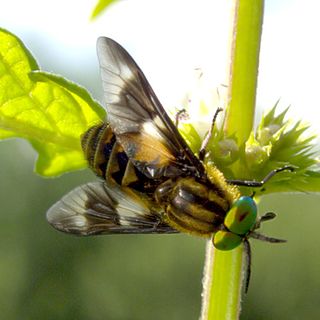Related Research Articles

Blepharisma is a genus of unicellular ciliate protists found in fresh and salt water. The group includes about 40 accepted species, and many sub-varieties and strains. While species vary considerably in size and shape, most are easily identified by their red or pinkish color, which is caused by granules of the pigment blepharismin.

The subfamily Microdontinae contains slightly more than 400 species of hoverflies and, while diverse, these species share several characteristics by which they differ from other syrphids. The Microdontinae are myrmecophiles, meaning they live in the nests of ants. Larval Microdontinae are scavengers or predators in ant nests, and, in contrast to other syrphid larvae, have no readily apparent body segmentation. Some species also do not exhibit the typical adult flower-visiting behaviour of other hoverflies, but instead remain near their larval host colonies.

Alcithoe is a genus of large sea snails, marine gastropod molluscs in the family Volutidae, the volutes.

Hover flies of the genus Microdon are unusual among the Diptera. Like other members of the subfamily, they are myrmecophiles, meaning they inhabit the nests of ants.

Mesostigmata is an order of mites belonging to the Parasitiformes. They are by far the largest group of Parasitiformes, with over 8,000 species in 130 families. Mesostigmata includes parasitic as well as free-living and predatory forms. They can be recognized by the single pair of spiracles positioned laterally on the body.

Superfamily Tabanoidea are insects in the order Diptera.

The Taiwanese mole shrew is one of four species of red-toothed shrews in the genus Anourosorex. It is endemic to Taiwan.

Chalcosyrphus is a genus of hoverflies in the subfamily Eristalinae. Many species exhibit some degree of mimicry of various sawflies and other hymenopterans and are often brightly coloured or metallic in hue. The adults are similar in structure and behavior to the related genus Xylota but differ in larval morphology. They can be found throughout Europe, Asia, and North America and seem to prefer damper, boggy habitats. The larvae are saproxylic feeders in rotten wood in these habitats.
Archimicrodon is a genus of hoverflies. Many of the species in this genus were moved from Microdon by Reemer & Ståhls (2013). Previously, it had been described as having three known species.
Chrysidimyia is a genus of hoverflies from Brazil, with only one known species, Chrysidimyia chrysidimima. The genus was described as a small metallic green fly with dense punctation that had an "astonishing resemblance" to chrysidid wasps.
Paramicrodon is a genus of hoverflies, with eight known species. They differ from Microdon by their short antennae and the lack of appendices on vein R4+5.
Paramixogaster is a genus of hoverflies, with 25 known species. Paramixogaster has an appendix on vein R4+5 that is absent in Mixogaster.
Pseudomicrodon is a genus of hoverflies, with 14 known species. All are species with petiolate abdomens.
Rhoga is a genus of hoverflies, with five known species. All are small, delicate, pale yellowish flies, with distinct black pilose brushes on their metatibiae. These flies are probably mimics of stingless bees of the tribe Meliponini.
Spheginobaccha is a genus of hoverflies, with 15 known species. The genus is readily separated from other microdons by the incomplete metathoracic bridge, round/oval basoflagellomere, occiput with a dorsolateral crease, and other characters.
Syrphipogon is a subgenus of the hoverfly genus Microdon. There are two known species. They are very large microdontine flies of about 25 mm. They have a deeply sulcate scutellum and a facial mystax. They are mimics of the large bees of the genus Eulaema.
Macrostomum is a genus of flatworm with a worldwide distribution, with over a hundred species described to date. These hermaphroditic, free-living flatworms are usually small in size, with large species reaching up to 5 mm in body length. They are usually transparent, and the smaller species appear rather round in cross-section than dorsoventrally flattened.

Monoceromyia is a genus of hoverfly. Species in the genus are found in the Afrotropical, Australasian, Neotropical and Oriental regions. They are mimics of wasps and the genus is distinguished by the metapleura being widely separate behind the hind coxae. The elongated frontal base of the antenna is at least as long as the basal segment of the antenna and the second abdominal tergum is longer than wide and constricted.
Rhigioglossa is a genus of horse flies in the family Tabanidae.
References
- ↑ Hull, Frank M. (1937). "New species of exotic syrphid flies" (PDF). Psyche . 44 (1–2): 12–32. doi: 10.1155/1937/46960 .
- 1 2 Reemer, Menno; Ståhls, Gunilla (2013). "Generic revision and species classification of the Microdontinae (Diptera, Syrphidae)". ZooKeys (288): 1–213. Bibcode:2013ZooK..288....1R. doi: 10.3897/zookeys.288.4095 . PMC 3690914 . PMID 23798897.